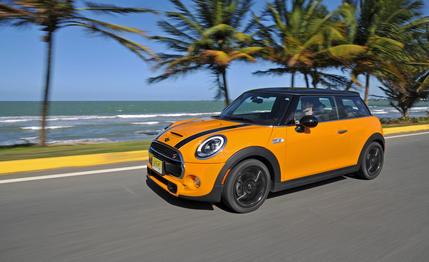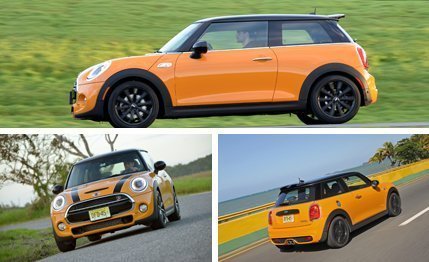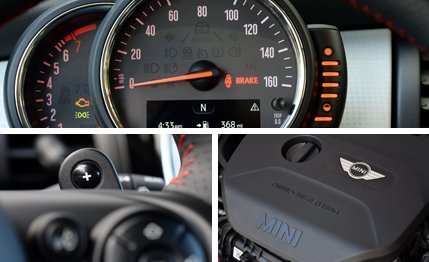
 First Drive Review
First Drive Review
Age and maturity usually go hand in hand, but not always in divorce court. The Mini Cooper and the Cooper S hit their third generation as slightly larger and somewhat less fitfully childish fashion accessories. The Mini as a whole has more comforts, more features, more inches here and there, and more presence and security on the road, even on the chuckholed goat paths of tropical Puerto Rico, where Mini decided to launch the car.
Why does the Mini grow when smallness is so directly evoked by the brand name? Some of the credit—or blame, depending on your perspective—goes to the new front-wheel-drive UKL platform that the new Mini will share with a full phylum of vehicles coming from Mini, BMW, and maybe even Rolls-Royce (no, not really). The Cooper and the Cooper S are the smallest of the UKL derivatives, we’re told, so the size increase is something of a compromise made unavoidable by the future Minis and BMWs that will use the architecture.


Not that the latest Mini has gotten grotesquely larger. Its extra 1.1 inches in wheelbase and 4.5 inches and 1.7 inches in overall length and width still make it shorter than the current Honda Fit, if slightly wider. With the styling, Mini sticks to its heritage as if glued by J-B Weld, and even those who profess to know cars will have trouble picking out the new model. Basically, the styling is laid further back, the nose and the wind-blown ellipses for headlights cooling off the in-your-face pug-nose look of the previous car. The mullet-fish eyes of the new, LED-ringed headlights and the enlarged, fully ovoid grille strongly evoke the Mini Rocketman concept of a few years ago. This is the German design team’s idea of an incremental modernization without a serious tampering of the Mini look. Where it goes from here is anybody’s guess. Retooling a Mini might be the worst job in car design, right up there with redesigning the Porsche 911.
New Hearts
The technical highlights of Mini 3.0 include two new engines that are a part of a modular family of BMW-designed and assembled inline mills that range from the 1.5-liter turbo three-cylinder in the base Cooper to the 2.0-liter turbo four-cylinder in the Cooper S. (A 3.0-liter inline-six will be spun off for BMW’s use soon.) If the displacement increments seem to have a cadence, it’s because the various cast aluminum engines are just stackings of a standardized 500-cc cylinder and combustion chamber. All feature the same 82-mm bore and 94.6-mm stroke, plasma-sprayed cylinder liners, direct injection, and Valvetronic throttleless airflow control.
We were most keen to drive the base Cooper with its new, 134-hp three-holer. With a base price of $20,745, Mini’s starting point increases $250 over the 2013 model. However, U.S.-spec cars are expected to have a curb weight gain of 60 to 90 pounds, to about 2700, thanks in part to a pair of new knee airbags, some strengthening of the C-pillar for crash standards, and extra foam in the front bumper. So this small engine, with its 162 lb-ft of torque, has its work cut out.


Embraced by a six-speed manual (a conventional planetary-gear six-speed auto is available), our little sample car needed a lot of throttle to keep it going up the grades into Puerto Rico’s highlands. The gearing is deep in first but rapidly stretches out for fuel economy, so if you go for third at the wrong moment, the engine seems to fall out the bottom and roll back down the hill. Even on a flat, acceleration is never what you’d call thrilling, although the engine with its single-scroll turbo never sounds bad or labored. Mini claims a 0-to-60-mph time of 7.3 seconds, a figure we greatly look forward to attempting to verify.
If you don’t mind the lack of scoot, or the lack of clutch feel on the manual, which can make the three-cylinder easy to stall at low speeds, you will get frugal operation. Mini is stating a preliminary EPA rating of 30 mpg city and 42 highway. If you’re a hard driver, expect its economy to be worse as you work over the engine. In fact, you may do better on gas mileage with the $24,395 Cooper S, as its 189-hp, 2.0-liter four gives it preliminary ratings of 28/40, very close to those of the base engine. A bigger engine working less hard can often achieve better economy than a smaller engine winding its lungs out.